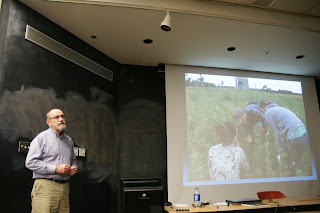Rod Walton authored this article which was originally published in Fermilab Today:
The Fermilab Village is home to a diverse community of trees, including exotic ornamental varieties and species native to our area. These trees provide a habitat for insects, birds and mammals as well as provide an appealing appearance and welcome shade in the summer. Unfortunately, approximately 150 ash trees exist among this collection.
This is unfortunate because these trees likely will become infected with emerald ash borers, an invasive, imported beetle that has decimated ash tree populations in the Midwest. Trees infected with this pest invariably die within a few years and can cause hazards when located near buildings or roads.

The beetles were
first discovered at Fermilab in 2007 along Kirk Road and since then, the infestation has spread to cover the entire site, including the Village. Many ash trees are now dead or dying as a result. Experts from the Illinois Department of Agriculture and the Morton Arboretum predict that virtually all our mature ash trees will die during the next few years.
In order to manage this imminent problem, Fermilab will begin preemptively removing ash trees in the Village, perhaps as early as this winter. As resources allow, the Roads and Grounds Department will continue to replace trees in the Village where it is appropriate to do so. Replacing these trees is something that our volunteers can help do during events such as our annual Arbor Day celebration. In the natural areas of the site, away from human activity, dead trees will be left standing to provide habitat for birds, insects and other wildlife. These trees will be incorporated into the future management of all Fermilab’s remaining natural areas.
Without prohibitively expensive chemical treatment, there is no viable defense against the emerald ash borer. Local municipalities and forest preserve districts are bracing for this problem now, and many neighboring municipalities are removing ash trees before they die or show overt signs of infestation. Preemptive removal of trees spreads out the cost and manpower needed to remove the trees safely and avoids the risks that standing dead trees create in populated areas.











